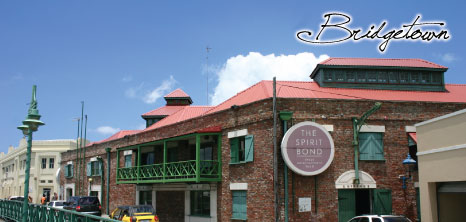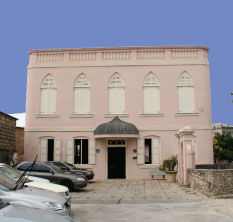|
BridgetownBridgetown as we know it now with its fascinating mixture of stunning architecture and history, is far different to the Bridgetown known of back in the day. As we look around today, we see Barbados' capital city and main tourist hub alive with hustle and bustle, shopping, businesses and as mentioned before, a wealth of history. Looking back we see, a Bridgetown that was roped in a political struggle and slave riot back in 1937, a Bridgetown that grew economically in leaps and bounds as a result of hard slave labour and a Bridgetown that became the nucleus for trade. A thriving trade that occurred during the seventeenth (17th), eighteenth (18th) and nineteenth (19th) centuries and saw many large warehouses being built on the Careenage, most of which were destroyed by a spate of fires and hurricanes. The Careenage was the place where ships were careened onto a side to be repaired, scrubbed and painted. Merchants docked their ships at the Careenage in Bridgetown where they would unload merchandise that was subsequently stored in nearby warehouses. This level of commercial trade no longer takes place at the Careenage but more instances of fishing boats and yachts docking here instead. Today, remnants of these previously built warehouses still stand in the original vicinity of the Careenage but have been converted into restaurants and shopping centers. The capital city of Bridgetown on the island of Barbados is one of the oldest cities in the Caribbean. It is surrounded by Carlisle Bay and the Bridgetown Port which is one of the most state of the art ports to be found anywhere in the Caribbean region. Admiral Lord Horation NelsonThe statue of Admiral Lord Nelson, was erected in Trafalgar Square in 1813 and is older than the statue and square of the same name that is found in London, England as it was erected some twenty-seven (27) years before that one. His popularity came as a result of the impression he made on Barbadians at the time, resulting in them purchasing the statue and land when he died, naming it Trafalgar Square and paying tribute to the Admiral by erecting the statue. This controversial statue has been a hub of contention for a while as the people of Barbados have been feeling the deep desire for this statue to be removed. To date, the only real change that has taken place with regards to Lord Nelson is the shifting of position of his statue to back Broad Street as opposed to facing Broad Street. Trafalgar Square was renamed National Heroes Square in 1999. Parliament Buildings of BarbadosThe Parliament buildings of Barbados were built as a primary source of adequate accommodation for the Houses of Parliament, to consolidate the major public offices and to safely and securely file any of Barbados' Public Records. These historic Parliament Buildings of Barbados were once known as the Public Buildings and are home to the House of Assembly and Senate of the island. With more than there hundred and fifty (350) years of history, these buildings were constructed from local limestone and completed in 1874 by a Gothic Architect. 1937 RiotsThe capital city of Bridgetown came alive in a different way in 1937 when Clement Payne, a political activist, went against all odds and held meetings in an effort to combat political and economic freedom on the island of Barbados. On the evening of July 26th, 1937, meetings were held and attended by crowds in the Lower Green and Golden Square to protest against the deportation of their "shepherd" Clement Payne. After the meetings, the crowds became uncontrollable. They roamed Bridgetown, smashing electric street lamps and the windscreens of motor cars. Order was eventually restored by the Police. Independence from the island's planters, however, didn't come until 1949. Religious BuildingsWithin the environs of Barbados' capital city Bridgetown, one will come across two (2) of the island's places of worship. There are St. Michael's Cathedral and the Jewish Synagogue, both of which are still located in their original mid-seventeenth century positions. St. Michael's Cathedral St. Michael's Cathedral was built in 1665 (the year of the Great Plague in London and one year before London's great fire) to accommodate approximately three thousand (3,000) worshipers but in 1780, a hurricane destroyed that structure. Nine (9) years later in 1789, a new building was constructed but once again, damage was suffered from another hurricane in 1831 that this time significantly destroyed the building, clock and bell tower. Such history abounds within the walls of the St. Michael's Cathedral that a stroll through the cemetery will expose you to tombstones dating as far back as the late 1600's and early 1700's. The Jewish Synagogue
The hurricane of 1831 caused considerable destruction to this synagogue and as a result was reconstructed but unfortunately ran to ruins and subsequently sold in 1929. The usage of the synagogue was activated in 1983 by the Jewish community of Barbados by way of an intricate restoration process. The active Jewish Synagogue in Bridgetown, Barbados is now a building protected by the Barbados National Trust and a proud winner of the American Express Preservation Award. Tyrol CotTo the north of the city of Bridgetown, one can find an 1854 constructed house by the name of Tyrol Cot. Once home to Sir Grantley Adams, the first premier of Barbados and the only Prime Minister of the Federation of the West Indies and birthplace of his son, Tom, the second Prime Minister of Barbados. This architectural gem possesses a captivating brew of Palladian and tropical vernacular. On the grounds of Tyrol Cot, there is a Heritage Village which sells arts and crafts, a chattel-house museum, garden and a restaurant. Tyrol Cot has been officially approved as one of Barbados' national treasures and hence managed and maintained by the Barbados National Trust which restored it and has been able to present it as a showcase of Adams' antique furniture and memorabilia. Other places of interest in and within the environs of Bridgetown include Bay Street, Belleville, Broad Street, Cenotaph War Memorial and the Chamberlain Bridge to name a few. Life in BridgetownAs upmarket as the commercial aspect of Bridgetown is, the residential aspect of the capital city in Barbados still houses a number of poorly constructed homes. Districts such as Pondside, Green Field and New Orleans come ti mind with regards to such. Obviously not overlooked by the Barbados Labour Party, who were in charge at the time, However, starting in the mid-1990s, efforts have been made by the present Owen Arthur administration to develop Bridgetown's residential districts under its Urban Development Commission. Poverty Alleviation programs have also raised the quality of life for the peoples of Bridgetown.
|
|
|

 The Jewish Synagogue is located in Bridgetown and was built by Jews who came to Barbados from Brazil in 1654. Their arrival on the island was as a result of them being informed that Oliver Cromwell had extended freedom of worship for Jews and as such, they were granted permission to settle in Barbados. Their presence on the island was heavily felt as they were adept at the sugar industry and were, in no time, able to pioneer the crop and hand over their skills in cultivation and production to the Barbados land owners.
The Jewish Synagogue is located in Bridgetown and was built by Jews who came to Barbados from Brazil in 1654. Their arrival on the island was as a result of them being informed that Oliver Cromwell had extended freedom of worship for Jews and as such, they were granted permission to settle in Barbados. Their presence on the island was heavily felt as they were adept at the sugar industry and were, in no time, able to pioneer the crop and hand over their skills in cultivation and production to the Barbados land owners.
